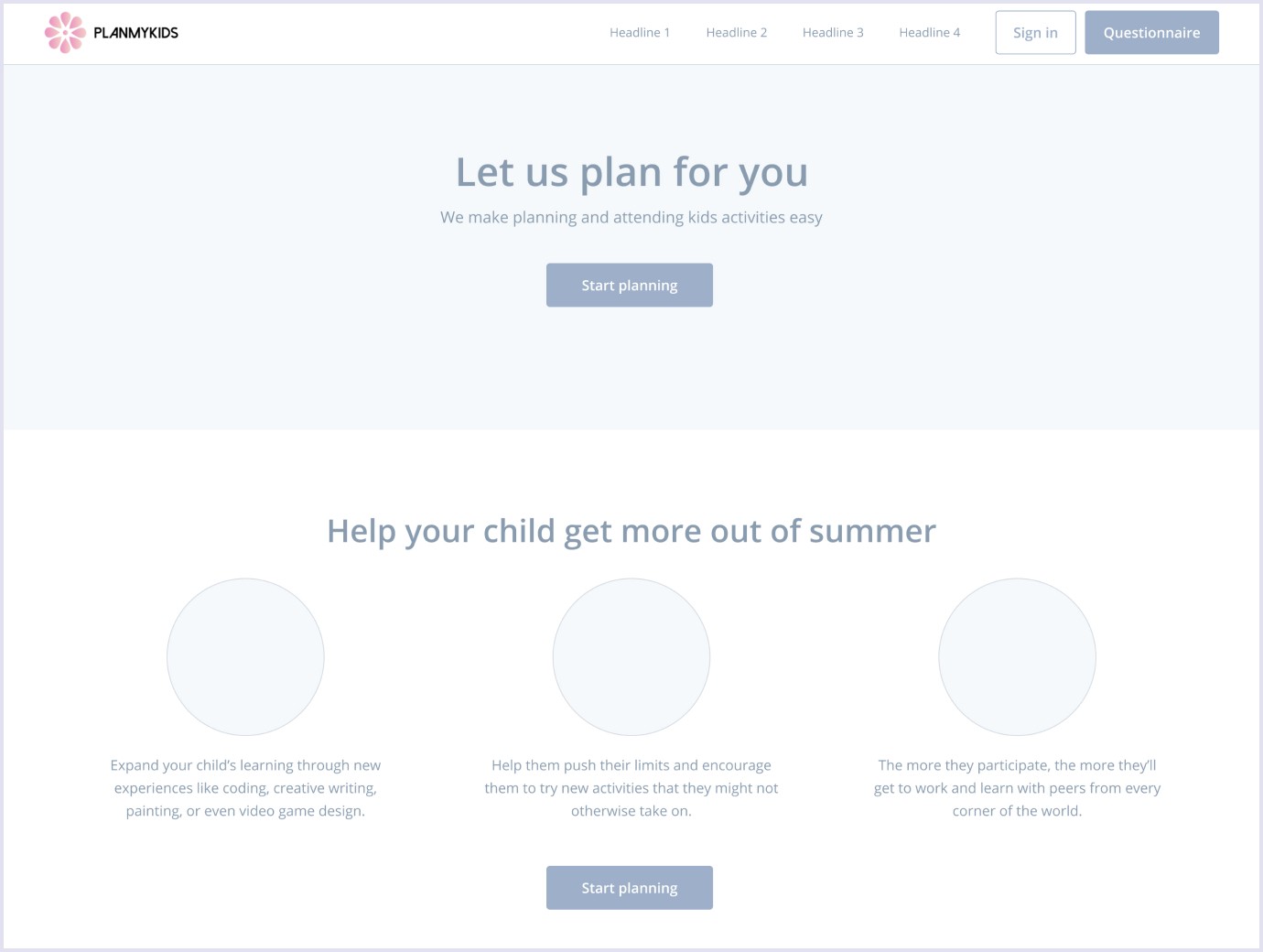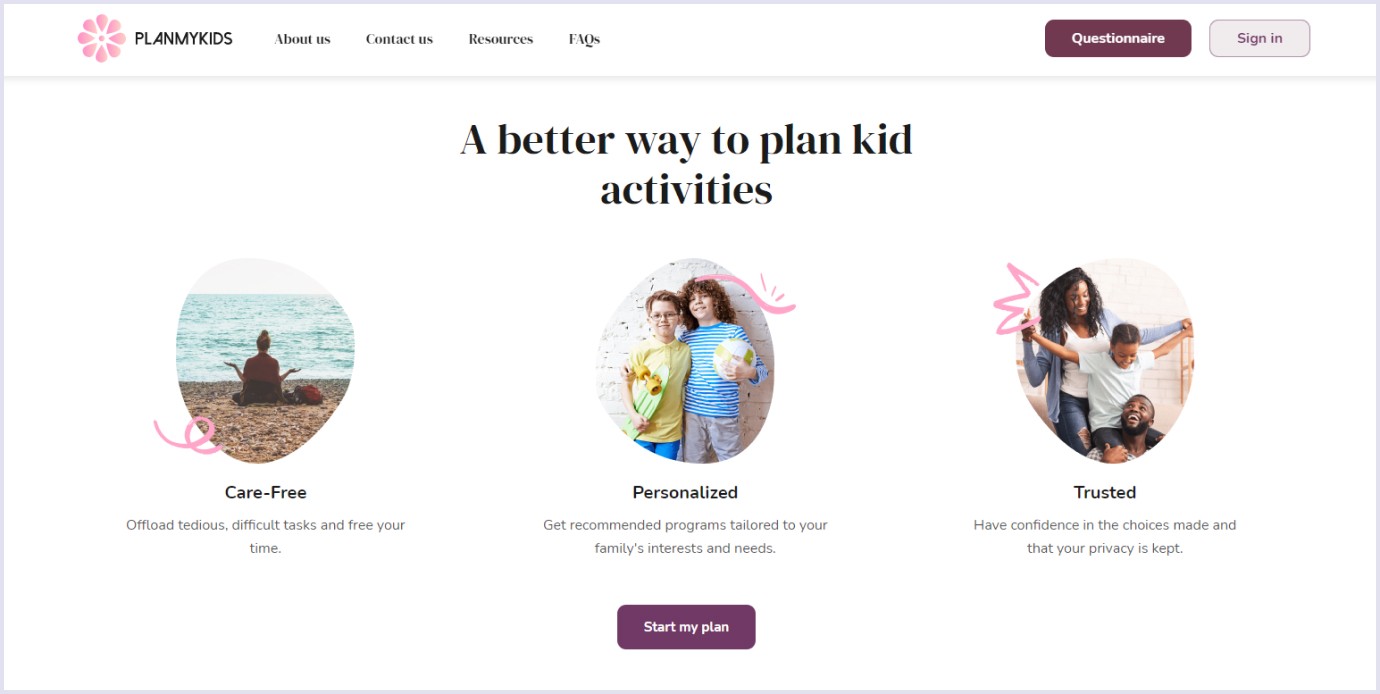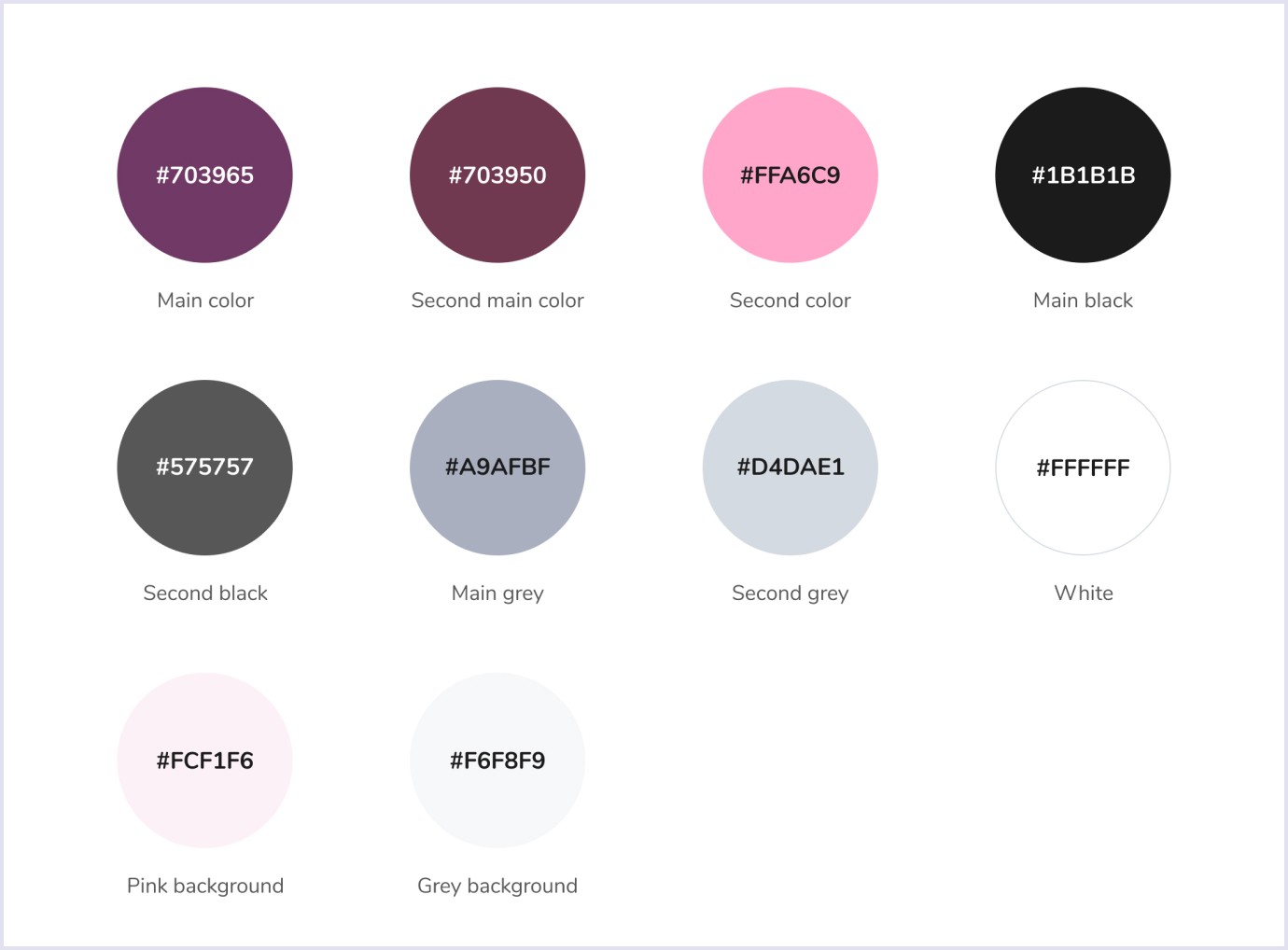In today’s hectic life keeping children busy after school is a pressing issue for many parents. Not only should they find the most suitable activities for kids, but they also have to monitor the schedule on the go.
Such activity booking marketplaces can become a silver bullet for both parents and service providers. Such platforms make it easier for both parties to plan, book, and coordinate these activities for children.
Today we would like to share our experience in building a kids activities marketplace. We will lead you through the key stages of custom software product development in our company - from a discovery session to the product launch.
PlanMyKids: what is the main project idea?
Every business starts with a simple idea that can be further expanded. So how can you find a successful business idea that later can turn into a profitable venture? You can start with fixing issues you face in everyday life.
Yelp is an example of the brand that successfully implemented this approach. Its founder, Jeremy Stoppelman, fell ill and could not find a recommendation for a doctor on the web. Then and there, he came up with an idea of creating a review website. This venture turned out highly profitable and brought revenue of $233,2 million in the fourth quarter of 2020.
A similar story happened to our customer David. He is the founder of a children's spare-time activities planner PlanMyKids. His family struggled to plan leisure activities for kids. Being busy parents, David and his family were short of time. The key information was all over the place. Besides, it seemed like parents needed to be project managers to coordinate all activities for kids properly.
After discussing these issues with other parents, David found out that they felt the same way. Parents were greatly dissatisfied with the children's events organization process. They were willing to try something different to save their time and find better options for their kids.
So David decided to try and turn things around. It is worth noting that from the very beginning the customer had a very strong project vision. David knew exactly what kind of online booking platform he was going to build and what for.
We felt we could change the status quo by creating a care-free, personalized, trusted digital service to connect parents and program providers - David Watkins, Founder of PlanMyKids
The customer was looking for a reliable development team to help him bring his idea to life, and found Codica while doing Internet research. Our team was chosen among other software agencies based on the following criteria:
- Experience in marketplace website development;
- Expertise of delivering MVP software development services;
- Extensive Ruby and Ruby on Rails skills;
- The capacity of working with Amazon cloud;
- Experience in providing progressive web app development services.

David submitted a request via our website, and so our journey together began.
Product Discovery sessions
Our collaboration with David and work on his project started with the product discovery stage. Our team firmly believes that this is the most important phase of online marketplace app development. Why is it so?
The thing is that the discovery session is a proven method to start a new project off right. At this stage you identify core constraints, choose the required functionality and tech stack. Besides, it is crucial to define the main risks related to your project.
Armed with this valuable information, you get better chances to build a successful and meaningful product.
Below you can see a chart that displays the importance of the project discovery session:

When it comes to PlanMyKids, we had quite a number of discovery sessions with the customer, all of them being proactive and informative. Our team had a lot of phone meetings with David. The aim was to get the key information about the future multi-vendor marketplace development service.
The project sessions with David were completed when the following goals were accomplished:
- The subject area was explored;
- The requirements for future activities booking system were defined;
- The list of must-have MVP functionality was prepared;
- Potential bottlenecks were identified;
- High-level solutions to supposed challenges were offered;
- We provided David with certain architecture solutions best suited for specific requirements.
In the long run after all details specified, we formed the project scope. After that, our team created a very detailed workflow for each online booking platform user role. Also, we chose the right technology stack. Then, the customer got the completed project documentation. Finally, David was provided with accurate time and cost estimates.
Business logic
We defined three different types of end-users. These are as follows:
- Parents/ guardians;
- Specialists;
- Admin.
A smooth and simple functionality workflow was created for each user type. In addition, we have integrated the Family Questionnaire workflow elaborated by David’s team.
As for competitive advantages of a product, the customer focused on the following:
- Easy activity providers participation;
- Smart match;
- Simple planning.
It is worth noting that David had specific business requirements. The kids marketplace was supposed to be completely secure and compliant with PCI and HIPAA regulations.
Technical requirements
The business logic of the future online booking platform had been discussed. Our next step was to compile a list of core technical requirements.
Building a fast and reliable progressive web app. It needed to be fully secure and optimized for both web and mobile devices. The PWA technology was chosen for the activities booking system, since it allows saving costs on mobile app development.
Researching and suggesting the most suitable solution regarding payment gateways integration.
Implementing only very basic functionality, since we were building a service marketplace MVP.
Adding Social login functionality was a must. The platform should enable users to sign in via their Facebook or Google accounts.
The technology stack
At this stage, we offered David the most advanced technology stack for his service marketplace. This way, we made sure that a fast-loading and reliable progressive web app will be delivered within a short time frame.
So let’s peek under the hood and find out what technologies were used by our team for PWA development.
React - our team has vast experience in making React progressive web applications. We firmly believe that this library is a great choice for building PWAs.
Rails API was used to build proper backend logic functioning.
Redis - this in-memory data structure store was chosen for its scalable cache infrastructure.
Amazon Web Services (AWS) is a secure and scalable cloud services platform. It provides users with database storage, computing power, and other functionality. They make it easier for customers to grow their business.
Redux is an open-source JavaScript library. It works well with React and is often used for creating user interfaces.
Sidekiq is a job scheduler with open-source code written in Ruby.
For more examples of using the PWA technology, take a look at this Insurance Progressive Web Application that Codica’s experts successfully delivered.
Prototyping
We find prototyping a great way to test real user experience before our team moves to the development stage.
What makes prototypes so important for custom marketplace development, you may wonder? First and foremost, they help build a website structure. Initially, we have only a vague idea and a brief explanation. When prototypes are built, the web page sequence is getting much clearer.
As applied to PlanMyKids, our aim was to show David how his future online marketplace for parents will look like and feel for both parents and activity providers. For a start, we created the website structure. After that, our team built user flow for both user roles (parents and platform specialists). Finally, we worked out how they would interact with each other.
Below you can see one of the earliest prototypes of a home page for PlanMyKids. It displays the future look of this monthly planner for kids activities.

Here you can see that the navigation bar is put in the header. Bear in mind that the detailed wording takes place at the design stage.
At the top of the screen, we marked with grey color the place where image, subtitle, and call-to-action would be.
Similarly, in the lower part, grey circles would be later replaced with photos with captions for each point.
As a result, prototypes of the online service marketplace allowed us to see the future placement of interface elements. Also, with their help David could fully understand which function each of web pages will carry.
To sum up, from the very beginning, we established highly effective communication with the customer. All requirements were specified quickly and we were able to take on the project right off the bat. We believe that this synergy along with the customer’s trust and confidence allowed us to build a successful user-friendly marketplace for kids.

Product design
The next stage in building a web solution is product design.
When building custom solutions for our clients, we adhere to the latest design guidelines. We make sure that all projects we deliver are visually-appealing and easy to use. The customer-first approach helps us create powerful online marketplaces, PWAs, and SaaS solutions.
Referring to PlanMyKids, we focused on making its design neat, eye-catching, and slick. Since the target audience was busy parents, our task was to avoid clutter and provide users with a convenient and clear website structure.

Let’s take a closer look at our UX/UI design services and how they were applied to the PlanMyKids online booking platform.
UX design practices
In terms of UX design, our task was to make the online marketplace for kids user-friendly to the max. We focused on creating consistent and easy-to-use interfaces.
Also, we made sure that navigation is simple and intuitive. It should allow users to find what they are looking for quickly and effortlessly. For example, we placed the questionnaire on the top of the page where parents are most likely to spot it.

Some users may find it hard to find the required information or take a particular action on your platform. Keeping this in mind, we created a special FAQ session aimed at educating, informing, and guiding parents. They will find answers to the most common questions there.
Contact information is crucial. For this reason, we put it in plain view. By clicking the contact us hyperlink and filling in a form, users can reach out to the platform managers.
UI design practices
Since we were building the kids marketplace, the idea was to make it less formal and official. Such an approach is reflected in the graphic design of the PlanMyKids website, including colors and images.
It is worth noting that our design team made a careful choice of a color scheme for this online marketplace for parents. Our task was to choose the colors that would go together perfectly.
Thus, purple and pink were used as the main colors. These vivid colors are often associated with creativity and exuberance. That's why they seemed a good choice for an online marketplace for kids.
At the same time, a combination of pink and purple colors lends a touch of elegance to the website design.
Below you can see the color palette we used for service marketplace PlanMyKids website design:

Besides, we added small elements to the web pages that remind children’ sloppy drawings. They allowed creating the desired playfulness.
Also, we achieved clarity of web design with the help of whitespace and typography. There are two types of fonts on the marketplace for kids. Serif was used for headlines and Sans Serif - for the longer copy to increase readability.
MVP development
As for product development, the customer’s decision was to start with MVP web development of the activity booking marketplace. This approach would allow David to get through the project with less risk and address the marketplace requirements.
In this regard, our primary task was to help David define the very basic functionality for the project. It should be enough for testing the marketing message and value proposition.
Also, it was crucial to choose the right features from the offset since neither the client nor our team wanted to over-engineer the solution.
Want to see more examples of a Minimum Viable Product? Take a look at this Accommodation Search Website MVP that Codica Team successfully delivered for a client from Australia.
MVP functionality
During the discovery session, we defined three user types and created the workflow for each of them. This way, we were able to define what functionality should be available for each user category.
For example, for parents/guardians, the workflow will look the following way.
- Parents fill in a self-guided survey.

The specialists get the request for an itinerary.
The system automatically selects suitable options.

Specialists check these activities for kids as to their relevance and make some changes per request.
When everything is fine, the specialists send an itinerary to parents.
Parents review it and can request any changes. When they get relevant activities for children, they can book and purchase them.
Given that, the basic functionality for parents includes:
- The questionnaire;
- Profiles;
- Calendar;
- Itinerary;
- Payment gateway.
Let’s take a closer look at each feature of the marketplace for kids that our team has delivered.
- Questionnaire

In this section, parents fill in the required information about their family and children. For parents' convenience, it is divided into five parts. These are contact info, camp preferences, dates, kids’ interests, and budget. Such a division makes it easy to fill in the required information.
At the same time, this detailed survey allows providing parents with the most relevant activities for kids.
- Parent's profile
Parents can check the current status of each itinerary: whether it is completed or in progress. Itineraries can be viewed both in text format or on the map. In addition, parents can leave comments if an itinerary does not suit them.
- Dashboard for platform specialists
This feature allows platform specialists to review all requests coming from parents. Besides, specialists can proceed to create an itinerary here too. Finally, they can see the status of each request (in process, denied).
- Calendar
We made sure that it is easy for parents to check dates when their children attend a particular camp. Also, it is possible to add more children and track their schedule and location. With this feature, it is getting easier for parents to plan their day since they know when they should drive their kids off and pick them up.

- Itinerary
It is a page where program specialists are searching for relevant activity providers. An advanced system of filters simplifies this task greatly. Camp cards contain the most important information such as name, location, and preferred dates. Also, we have added icons and camp-related data. This info helps parents understand whether the camp is relevant or not. If it is, specialists add it to the itinerary.
On the right side of the web page, parents can see which camps have been added to a particular itinerary.
- Payment gateway
Stripe was integrated to provide parents with a fast and convenient way of purchasing the suitable activities for kids.
- Notifications
Owing to messaging functionality, parents can receive reminders and updates. Also, parents get email notifications when the itinerary is available for review.
This is the very basic functionality for parents available on the kids activities marketplace. It is worth noting that sometimes the customer got too ambitious with features. Then our development team helped him stay focused on the MVP web development goals.
Below you can see a video testimonial from David Watkins, the Founder of PlanMyKids.
Agile approach in development
When building the PlanMyKids platform, following the Agile methodology, we divided the project into smaller parts. They are known as sprints. This approach is effective since it makes the delivery of new functionality frequent and predictable.
During the sprint review we track the progress on the project board, add new changes to the staging instance.
Owing to this transparent approach, customers can see anytime what has been done on their project.
Each sprint ends with a retrospective. It helps our team find out if there are any issues on the project and take timely measures to solve them.
QA, maintenance and support
Before we delivered the completed online service marketplace to David, we made sure that each function works properly. For this purpose, our highly-skilled Quality Assurance engineers performed manual and automated tests. With their help, our specialists were able to identify any possible bugs and fix them as soon as possible. Currently we support the PlanMyKids website on a regular basis. It means that we monitor the platform’s performance to make sure that it operates as supposed to 24/7.
When David wants to expand this kids activities marketplace by adding new features or locations, we will happily assist him.

Final words
To sum up, we would like to quote our client, as we believe that his words are the best evidence of our expertise, hard work, and dedication.
Working with the Codica team has been a great experience. All the value we thought they would provide during the selection process was met during the delivery.
Our team spent a good time working with a parent focus group to narrow down our MVP features which Codica brought to life through prototypes. When we got too ambitious with features, Codica team helped ground us with reminders of our MVP web development - David Watkins, Founder of PlanMyKids
For our part, we would add that the effective communication with David, allowed us to launch his website in less than six months. The kids activities marketplace can be further expanded by adding new features and widening its geography.
Learn more about this activity booking marketplace in the detailed Case study.
If you are looking for a reliable custom software development agency for your project, we will be happy to assist you. We have delivered multiple software projects for different industries, and eagerly embrace new challenges. Contact us to discuss your project idea.

